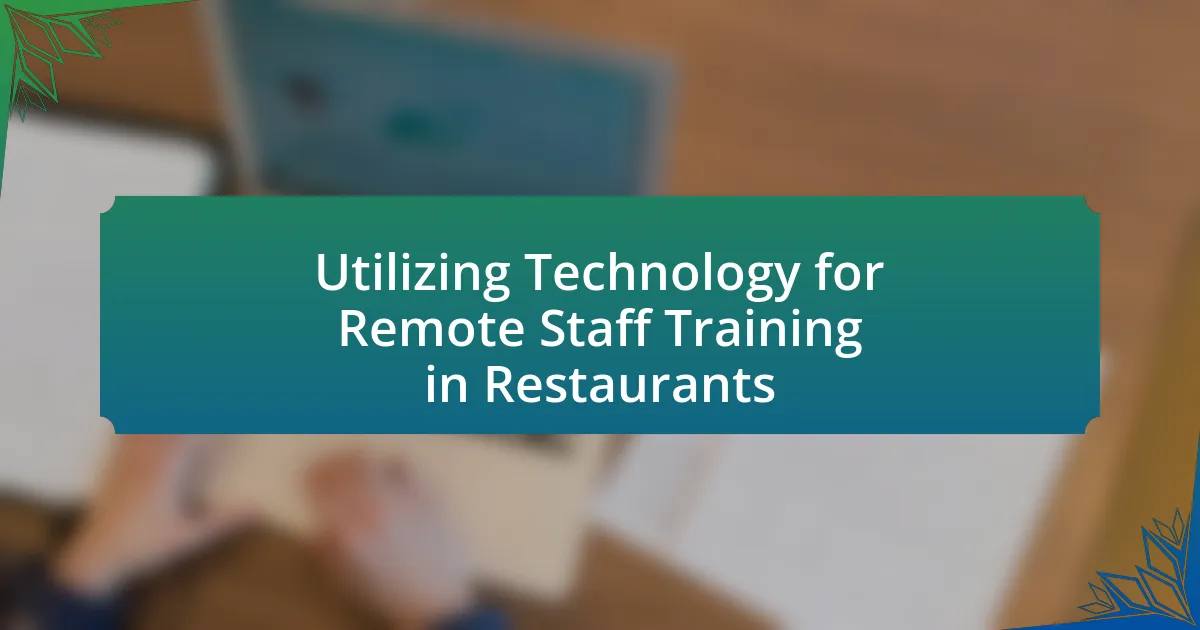The article focuses on the strategies for training Front-of-House and Back-of-House staff in the hospitality industry. It outlines the key differences in training approaches, emphasizing that Front-of-House training prioritizes customer interaction and service skills, while Back-of-House training concentrates on operational procedures and food safety. The article discusses the specific skills required for each group, the importance of tailored training programs, and the role of technology and feedback in enhancing training effectiveness. Additionally, it addresses common challenges organizations face in training both staff types and highlights best practices for successful training outcomes.

What are the key differences between Front-of-House and Back-of-House staff training?
Front-of-House staff training focuses on customer interaction, communication skills, and service etiquette, while Back-of-House staff training emphasizes operational procedures, food safety, and technical skills. Front-of-House training often includes role-playing scenarios to enhance guest relations and conflict resolution, whereas Back-of-House training involves hands-on practice in kitchen operations and adherence to health regulations. For instance, a study by the National Restaurant Association highlights that effective Front-of-House training can increase customer satisfaction scores by up to 20%, while rigorous Back-of-House training is crucial for maintaining compliance with food safety standards, which can reduce health violations by 30%.
How do the roles of Front-of-House and Back-of-House staff differ?
Front-of-House staff primarily interact with customers, focusing on service delivery, communication, and creating a welcoming atmosphere, while Back-of-House staff work behind the scenes, concentrating on food preparation, inventory management, and operational support. The distinction is evident in their responsibilities; Front-of-House roles include waitstaff, hosts, and cashiers who directly engage with patrons, whereas Back-of-House roles encompass chefs, kitchen staff, and maintenance personnel who ensure the establishment runs smoothly. This separation of duties is crucial for operational efficiency, as it allows each group to specialize in their respective areas, ultimately enhancing the overall customer experience.
What specific skills are required for Front-of-House staff?
Front-of-House staff require strong communication skills, customer service expertise, and the ability to multitask effectively. Communication skills are essential for interacting with guests, addressing inquiries, and conveying information clearly. Customer service expertise ensures that staff can meet and exceed guest expectations, fostering a positive experience. The ability to multitask is crucial in a fast-paced environment, allowing staff to manage various responsibilities simultaneously, such as taking orders, serving food, and handling payments. These skills are validated by industry standards, which emphasize the importance of effective guest interactions and operational efficiency in hospitality settings.
What specific skills are required for Back-of-House staff?
Back-of-House staff require specific skills such as culinary expertise, food safety knowledge, time management, teamwork, and attention to detail. Culinary expertise ensures that staff can prepare and cook food to high standards, while food safety knowledge is critical for maintaining hygiene and preventing foodborne illnesses. Time management skills enable staff to work efficiently during busy periods, and teamwork is essential for coordinating tasks with other kitchen personnel. Attention to detail is necessary for following recipes accurately and ensuring presentation quality. These skills collectively contribute to the overall success of kitchen operations in a restaurant setting.
Why is tailored training important for each group?
Tailored training is important for each group because it addresses the specific skills and knowledge required for their distinct roles. Front-of-house staff, such as servers and hosts, need training focused on customer service, communication, and sales techniques to enhance guest experiences. In contrast, back-of-house staff, including chefs and kitchen staff, require training in food safety, cooking techniques, and inventory management to ensure operational efficiency. Research indicates that customized training programs lead to improved performance and job satisfaction, as they align with the unique responsibilities and challenges faced by each group. For example, a study by the National Restaurant Association found that targeted training can increase employee retention rates by up to 25%, demonstrating the effectiveness of tailored approaches in the hospitality industry.
How does customer interaction influence Front-of-House training?
Customer interaction significantly influences Front-of-House training by shaping the skills and competencies required for effective service delivery. Front-of-House staff must be trained to communicate effectively, manage customer expectations, and resolve conflicts, all of which are directly informed by the nature of customer interactions. For instance, a study by the Cornell University School of Hotel Administration found that training programs that incorporate role-playing scenarios based on real customer interactions lead to improved service quality and customer satisfaction. This evidence underscores the necessity of integrating customer interaction experiences into training curricula to enhance the performance of Front-of-House staff.
What operational efficiency factors affect Back-of-House training?
Operational efficiency factors that affect Back-of-House training include workflow optimization, staff scheduling, and resource allocation. Workflow optimization ensures that training aligns with kitchen processes, enhancing productivity and reducing downtime. Effective staff scheduling allows for training sessions to occur during less busy periods, minimizing disruption to operations. Resource allocation, including the availability of training materials and tools, directly impacts the quality and effectiveness of the training provided. These factors collectively contribute to a more efficient training process, ultimately improving overall operational performance in the Back-of-House environment.

What strategies can be employed for effective Front-of-House training?
Effective Front-of-House training can be achieved through a combination of role-playing, comprehensive onboarding, and continuous feedback mechanisms. Role-playing allows staff to practice real-life scenarios, enhancing their customer service skills and confidence. Comprehensive onboarding ensures that new employees understand the establishment’s values, policies, and procedures, which is crucial for maintaining consistency in service. Continuous feedback mechanisms, such as regular performance reviews and customer feedback analysis, help staff identify areas for improvement and reinforce positive behaviors. These strategies are supported by research indicating that hands-on training and ongoing support significantly improve employee performance and customer satisfaction in hospitality settings.
What are the best practices for training Front-of-House staff?
The best practices for training Front-of-House staff include comprehensive onboarding, role-playing scenarios, continuous feedback, and customer service training. Comprehensive onboarding ensures that staff understand the restaurant’s culture, menu, and service standards, which is crucial for delivering a consistent guest experience. Role-playing scenarios allow staff to practice handling various customer interactions, enhancing their problem-solving skills and confidence. Continuous feedback from supervisors helps staff identify areas for improvement and reinforces positive behaviors. Customer service training focuses on communication skills, empathy, and conflict resolution, which are essential for creating a welcoming atmosphere. These practices are supported by industry research indicating that well-trained staff significantly improve customer satisfaction and retention rates.
How can role-playing enhance Front-of-House training?
Role-playing can enhance Front-of-House training by providing realistic scenarios that improve customer service skills and problem-solving abilities. This interactive method allows staff to practice handling various situations, such as difficult customers or high-pressure environments, in a safe setting. Research indicates that experiential learning, like role-playing, increases retention of information and skills, leading to better performance in real-life situations. For example, a study published in the Journal of Hospitality & Tourism Education found that role-playing significantly improved participants’ confidence and communication skills, essential for effective Front-of-House operations.
What technology can support Front-of-House training initiatives?
Learning Management Systems (LMS) can support Front-of-House training initiatives by providing a centralized platform for training content delivery, tracking progress, and assessing employee performance. These systems enable organizations to create interactive training modules that can be accessed remotely, ensuring that staff can learn at their own pace. According to a report by the Brandon Hall Group, companies that utilize LMS for training see a 24% increase in employee engagement and a 42% increase in productivity, demonstrating the effectiveness of this technology in enhancing training outcomes.
How can feedback be integrated into Front-of-House training?
Feedback can be integrated into Front-of-House training through structured evaluation methods, such as regular performance reviews and real-time feedback sessions. These methods allow trainers to assess staff interactions with customers and provide immediate, actionable insights that enhance service quality. Research indicates that organizations implementing continuous feedback mechanisms see a 14.9% increase in employee performance (Gallup, 2016). By fostering a culture of open communication, Front-of-House staff can receive constructive criticism and recognition, leading to improved customer experiences and staff morale.
What methods can be used to gather feedback from Front-of-House staff?
Surveys and questionnaires are effective methods to gather feedback from Front-of-House staff. These tools allow management to collect structured responses on various aspects of their work environment, job satisfaction, and operational challenges. Research indicates that 70% of employees prefer anonymous surveys, which can lead to more honest and constructive feedback. Additionally, regular one-on-one meetings provide an opportunity for direct communication, enabling staff to express concerns and suggestions in a personal setting. Implementing suggestion boxes can also encourage ongoing feedback, as they allow staff to share their thoughts at any time without the pressure of immediate discussion.
How can feedback improve training outcomes for Front-of-House staff?
Feedback can significantly enhance training outcomes for Front-of-House staff by providing specific, actionable insights that guide performance improvement. When Front-of-House staff receive regular feedback, they can identify areas needing development, such as customer interaction skills or service efficiency. Research indicates that organizations that implement structured feedback mechanisms see a 14.6% increase in employee performance, as highlighted in a study by the Harvard Business Review. This structured feedback not only boosts individual confidence but also fosters a culture of continuous learning, ultimately leading to improved customer satisfaction and operational effectiveness.

What strategies can be employed for effective Back-of-House training?
Effective Back-of-House training can be achieved through hands-on experience, structured onboarding programs, and continuous feedback mechanisms. Hands-on experience allows staff to engage directly with equipment and processes, enhancing their practical skills. Structured onboarding programs provide a clear framework for new employees, ensuring they understand their roles and responsibilities from the outset. Continuous feedback mechanisms, such as regular performance reviews and peer evaluations, foster an environment of improvement and accountability, which is essential for maintaining high operational standards. These strategies are supported by industry best practices, which emphasize the importance of practical training and ongoing development in achieving operational efficiency and staff competency.
What are the best practices for training Back-of-House staff?
The best practices for training Back-of-House staff include structured onboarding, hands-on training, and continuous education. Structured onboarding ensures that new employees understand their roles and responsibilities clearly, which is critical for operational efficiency. Hands-on training allows staff to learn through practical experience, which is essential in a fast-paced kitchen environment where skills must be applied immediately. Continuous education, such as workshops and certifications, keeps staff updated on industry standards and safety protocols, enhancing overall performance and compliance. According to the National Restaurant Association, effective training programs can lead to a 20% increase in employee retention, demonstrating the importance of investing in comprehensive training for Back-of-House staff.
How can hands-on training benefit Back-of-House staff?
Hands-on training significantly benefits Back-of-House staff by enhancing their practical skills and operational efficiency. This type of training allows staff to engage directly with equipment and processes, leading to improved competency in tasks such as food preparation, inventory management, and safety protocols. Research indicates that employees who undergo hands-on training are 75% more likely to retain information compared to those who learn through traditional methods, thereby increasing productivity and reducing errors in a fast-paced environment.
What role does safety training play in Back-of-House training?
Safety training is essential in Back-of-House training as it ensures that staff are equipped to handle potential hazards in a kitchen or food preparation environment. This training reduces the risk of accidents, such as slips, cuts, and burns, which are common in these settings. According to the Occupational Safety and Health Administration (OSHA), proper safety training can decrease workplace injuries by up to 40%, highlighting its critical role in maintaining a safe work environment. By integrating safety protocols into Back-of-House training, establishments not only comply with legal requirements but also foster a culture of safety that enhances employee well-being and operational efficiency.
How can technology enhance Back-of-House training?
Technology can enhance Back-of-House training by providing interactive learning platforms that facilitate skill development and knowledge retention. For instance, using virtual reality (VR) simulations allows staff to practice complex tasks in a risk-free environment, leading to improved performance and confidence. Additionally, mobile training applications enable on-the-go access to training materials, ensuring that employees can learn at their own pace and revisit content as needed. Research indicates that organizations utilizing technology in training see a 30% increase in employee engagement and a 25% improvement in knowledge retention, demonstrating the effectiveness of these tools in enhancing Back-of-House training.
What tools are available for online training for Back-of-House staff?
Online training tools for Back-of-House staff include Learning Management Systems (LMS) like Moodle and TalentLMS, which facilitate course creation and tracking. Additionally, platforms such as Coursera and Udemy offer specialized courses tailored to culinary skills and food safety. These tools provide interactive content, assessments, and progress tracking, ensuring effective skill development. Research indicates that organizations utilizing LMS for training report a 42% increase in employee performance, demonstrating the effectiveness of these tools in enhancing Back-of-House staff training.
How can data analytics improve Back-of-House training effectiveness?
Data analytics can improve Back-of-House training effectiveness by identifying skill gaps and optimizing training content based on performance metrics. By analyzing data from employee assessments, feedback, and operational efficiency, organizations can tailor training programs to address specific weaknesses, ensuring that staff acquire the necessary competencies. For instance, a study by the Association for Talent Development found that organizations using data-driven training approaches saw a 20% increase in employee performance. This evidence supports the notion that leveraging data analytics leads to more targeted and effective training solutions in Back-of-House operations.
What common challenges do organizations face in training Front-of-House and Back-of-House staff?
Organizations commonly face challenges in training Front-of-House and Back-of-House staff due to differences in skill requirements and communication barriers. Front-of-House staff typically require strong interpersonal skills and customer service training, while Back-of-House staff need technical skills and operational knowledge. This divergence can lead to inconsistent training approaches, making it difficult to create a cohesive team. Additionally, communication barriers arise from the distinct roles and responsibilities, which can hinder collaboration and understanding between the two groups. Research indicates that effective training programs must address these differences to ensure both teams work harmoniously, ultimately impacting overall service quality and operational efficiency.
What are the key takeaways for successful training of both Front-of-House and Back-of-House staff?
Successful training of both Front-of-House and Back-of-House staff requires a structured approach that emphasizes clear communication, role-specific training, and ongoing evaluation. Clear communication ensures that all staff understand their responsibilities and the expectations of their roles, which is critical for maintaining service quality and operational efficiency. Role-specific training tailors the learning experience to the unique demands of each position, enhancing skill acquisition and job performance. Ongoing evaluation, through regular feedback and assessments, allows for continuous improvement and adaptation to changing operational needs. These strategies collectively foster a cohesive team environment and improve overall service delivery.




